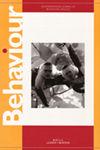Comparative exploratory movements of two terrestrial isopods (suborder: Oniscidea), in response to humidity and availability of food
IF 1
4区 生物学
Q4 BEHAVIORAL SCIENCES
引用次数: 0
Abstract
Unfavourable conditions within familiar environments may prompt organisms to make forays into other habitats, at least temporarily. This behaviour is in turn linked to key demographic processes such as immigration, emigration, and eventually, metapopulation dynamics. How such movements are triggered by environmental conditions (much less their interaction effects) has rarely been experimentally tested. To address this, we examined how environmental conditions (3 levels of food and 3 levels of humidity) within a microcosm affect the movements of two species of isopods (Armadillidium vulgare and Porcellio scaber) out of their familiar habitat. We used web-camera checkpoints to record the movements of individually marked animals as they conducted forays along corridors that lead to new, unused habitats. Thirty-six trials were run in total for each species, with each trial involving 16 animals (8 ♂♂, 8 ♀♀). Relatively unfavourable conditions of low humidity, low food levels, and their interaction prompted changes to all the foray metrics we measured. However, different levels of mobility and tolerance to desiccation between the two species also appeared linked to the degree of responses, e.g., Porcellio demonstrated a greater tendency to depart from familiar habitat under low humidity, possibly due to their superior mobility and greater susceptibility to desiccation. This study improves our understanding of how different environmental conditions act in concert to affect the exploratory movements away from familiar habitat, and how these responses differ even for closely-related species.两种陆生等足类动物(蛇足亚目:蛇足亚目)对湿度和食物供应的响应
熟悉环境中的不利条件可能会促使生物侵入其他栖息地,至少是暂时的。这种行为反过来又与关键的人口过程有关,如移民、移民,并最终与元人口动态有关。这种运动是如何被环境条件触发的(更不用说它们的相互作用了),很少得到实验测试。为了解决这个问题,我们研究了微观世界中的环境条件(3级食物和3级湿度)如何影响两种等足类动物(Armadillidium vulgare和Porcellio scaber)离开它们熟悉的栖息地的运动。我们使用网络摄像机检查站记录下单独标记的动物在走廊上的活动,这些走廊通向新的、未使用的栖息地。每个物种共进行36次试验,每次试验16只动物(8只♂♂,8只♀♀)。相对不利的低湿度条件,低食物水平,以及它们的相互作用促使我们测量的所有突袭指标发生变化。然而,两种植物的移动性和对干燥的耐受性的不同程度也与响应程度有关,例如,坡斯利奥在低湿度条件下表现出更大的离开熟悉栖息地的倾向,这可能是由于它们具有优越的移动性和更大的干燥敏感性。这项研究提高了我们对不同环境条件如何协同作用来影响远离熟悉栖息地的探索运动的理解,以及这些反应如何在密切相关的物种之间有所不同。
本文章由计算机程序翻译,如有差异,请以英文原文为准。
求助全文
约1分钟内获得全文
求助全文
来源期刊

Behaviour
生物-动物学
CiteScore
1.80
自引率
7.70%
发文量
44
审稿时长
3 months
期刊介绍:
Behaviour is interested in all aspects of animal (including human) behaviour, from ecology and physiology to learning, cognition, and neuroscience. Evolutionary approaches, which concern themselves with the advantages of behaviour or capacities for the organism and its reproduction, receive much attention both at a theoretical level and as it relates to specific behavior.
 求助内容:
求助内容: 应助结果提醒方式:
应助结果提醒方式:


